Climate change is a pressing issue facing our world today. Every day, we see the effects of rising global temperatures – from extreme weather events to diminishing ice caps. In 2013, for a stark example, the level of carbon dioxide in the atmosphere went over 400 parts per million for the first time in human records.
This fact alone underlines the urgent need for action.
Our blog explores five effective strategies to tackle climate change. These include boosting green energy use, making buildings more energy-efficient, planting more trees, adopting farming methods that protect our earth, and investing in technologies that can capture carbon from the air.
Each approach offers a path to reducing greenhouse gas emissions and helps limit global warming. Continue reading to find ways you can contribute to this global effort.
Five Ways To Mitigate Climate Change – Key Takeaways
- Using energy from the sun and wind instead of coal and oil helps stop harmful gases.
- Upgrading buildings with better lights, heating, and insulation cuts down gas that warms our planet.
- Trees are important because they breathe in CO2; planting more helps the earth.
- Farmers can help by changing how they grow food, using less water and fewer chemicals.
- Putting money into tech that grabs CO2 from the air or stops it before leaving factories will make a big difference.
1. Enhance Renewable Energy Adoption

Switching to renewable energy sources like wind and solar power cuts down on CO2 emissions. This move is crucial for fighting climate change. Countries are setting targets to increase the use of these clean energies.
For example, under the Paris Agreement, nations have committed to reducing their carbon footprint through Nationally Determined Contributions (NDCs). These efforts show a global push towards cleaner, sustainable energy.
Making more electricity with sun and wind also helps lower reliance on fossil fuels. Developed countries aim to limit national emissions with economy-wide caps. Developing areas focus on specific programs that support green projects.
Together, all countries share updates every five years on their progress under the Paris Agreement. Next, let's examine improving energy efficiency in buildings and industry as another key step forward.
2. Improve Energy Efficiency in Buildings and Industry

Making buildings and industries more energy efficient is a sure way to cut down on greenhouse gases. We can do this by upgrading insulation, lighting, and heating systems. For instance, using LED bulbs instead of traditional ones saves a lot of electricity.
Likewise, smart thermostats in homes and offices make sure we only use energy when we need it, reducing waste.
In factories, replacing old machines with new technologies that use less power helps too. This includes everything from high-efficiency motors to modern cooling systems. Such changes reduce carbon emissions and lower the cost of running these buildings and industries over time.
It's clear: improving energy efficiency is both an economic and environmental win.
3. Expand Forestation and Reforestation Efforts
Planting more trees and bringing back forests are sure steps against climate crisis. Countries around the world aim to cut down less trees and grow more. This helps because trees take in carbon dioxide, a major greenhouse gas.
In developing countries, efforts focus on stopping the loss of forests and planting new ones.
Places with lost trees get new life through reforestation. Activities reduce emissions from cutting down forests and fighting forest degradation hold great value.
4. Promote Sustainable Agriculture Practices
Farmers play a key role in fighting climate change. Adopting smart farming strategies can drastically cut down emissions and help the planet. These methods include rotating crops, using less water, and reducing chemical use.
Climate-smart policies encourage such practices, leading to healthier soil and better crop yields.
Local governments support these efforts by improving how we store and use water for agriculture. This makes sure farms have enough water without wasting it. WWF works with farmers to understand how changes in weather affect crops and animals.
Together, they find ways to adapt, ensuring food security for all of us.
5. Increase Investment in Carbon Capture Technologies
After adopting sustainable agriculture practices, turning our focus to carbon capture technologies is crucial. Such methods grab CO2 directly from the air or catch it at emission sources like power plants.
Investing more in these technologies can dramatically lower GHG emissions. Plants that use this tech turn harmful CO2 into something useful or store it deep underground where it can't warm the planet.
Countries and companies are spending billions on developing better carbon capture methods. They aim to make them affordable and efficient for widespread use. Examples include using biochar as a soil additive, which locks carbon away for centuries, and enhancing natural gas plants with equipment to catch emissions before they escape into the atmosphere.
These steps are vital for hitting net-zero targets and fighting global warming effectively.
Conclusion – Five Ways To Mitigate Climate Change
Fighting climate change requires us to take bold steps now.
Boosting renewable energy like solar and wind power cuts down harmful gases from coal and oil. Making buildings and industries more energy-efficient saves tons of emissions.
Planting more trees and restoring forests absorb CO2, acting as the earth's lungs in tackling air pollution.
Sustainable farming methods reduce methane and nitrous oxide while investing in technologies that capture carbon dioxide can significantly lower levels in the atmosphere.
Together, these actions form a strong defence against global warming, aiming for a cooler planet for all of us.
FAQs
1. What actions reduce CO2 emissions?
Switch to clean energy, like wind and solar power. Drive electric vehicles. Recycle more. Cut down on food waste.
2. How does planting trees help climate change?
Trees act as carbon sinks, absorbing CO2 from the atmosphere. This process reduces greenhouse gases.
3. Can changing our diet impact climate change?
Yes, eating less meat lowers methane emissions from livestock and reduces your carbon footprint.
4. Why is using public transport important for the environment?
Public transport reduces the number of cars on the road, cutting down CO2 emissions and improving air quality.
5. What role do oceans play in mitigating climate change?
Oceans absorb a large amount of CO2, helping to regulate global temperatures and mitigate climate impacts.
6. How does sustainable management of land help?
It preserves natural habitats like peatlands and grasslands that store carbon, preventing its release into the atmosphere.







